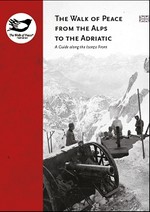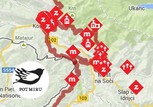World War 1 casualties
The historical literature on World War I is still arguing about the number of WWI casualties, with a range between 6 and 13 million. The main reason for the different estimates lies in the term 'loss', which in the military terminology of the time included all those soldiers who were no longer able to fight, and who may have been dead, wounded or captured. Nevertheless, some figures relating to military losses are more accurate, specifically those concerning soldiers who died on the battlefield or as prisoners of war. Of the 60 million soldiers who fought in the First World War, over 9 million were killed — 14% of the combat troops or 6,000 dead soldiers per day. The armies of the Central Powers mobilised 25 million soldiers and 3.5 million of them died. The Entente Powers deployed 40 million soldiers and lost more than 5 million. The mortality rate ranged between 6% and 30%, with the highest in the armies of Serbia, Montenegro and the Turkish Empire, mainly due to large epidemics of cholera, typhoid and smallpox, against which the armies of other countries vaccinated their troops. Infectious diseases did also spread in other armies, but with a lower mortality rate. In absolute numbers, major battles on all fronts claimed the highest number of casualties, primarily because of the technology of warfare based on explosive artillery shells. The death toll among prisoners of war amounted to between 5 and 10 % of prisoners.
The Austro-Hungarian army mobilised around 8 million soldiers, of whom 1,016,000 (12.7%) died, 1,691,000 were missing (21.1%), while 437,000 officers and soldiers were taken captive by the Italians as prisoners of war after the signing of the Armistice; around 478,000 officers and soldiers died in Russian, Serbian and Italian captivity. The Austro-Hungarian army supposedly deployed 160,000 soldiers from the Slovenian territory to fight on WW1 battlefields. The current estimates suggest that approximately 35,000 of them died by the end of 1917. Some estimates indicate that the Isonzo Front battlefields claimed from 2,000 to 3,000 lives of Slovenian soldiers. After the war, the number of those disabled from the war in the Slovenian part of the Kingdom of Serbs, Croats and Slovenes amounted to 11,467, and about 30,000 war widows had to take care of around 49,000 war orphans.
Data on civilian casualties from WWI are very limited and uncertain, suggesting an estimated 6 million casualties among the civilian population. The highest death rate was caused by hunger, deprivation and disease, while we should not neglect the civilian casualties suffered during military occupation and retaliation (Belgium, Serbia, Galicia, Isonzo Front), among which the Armenian genocide in Turkey, which claimed between 1 and 2 million dead Armenians, stands out.
Entente Powers | Population (million) | Mobilised soldiers | Dead soldiers | Civilian casualties | Total number of dead |
Great Britain and Ireland | 46.1 | 6,100.000 | 750,000 | 600,000 | 1.350,000 |
Belgium | 7.6 | 292,000 | 38,000 | 50,000 | 88,000 |
France | 39.0 | 8.100,000 | 1,327,000 | 600,000 | 1,927,000 |
Greece | 4.9 | 449,000 | 25,000 |
| 25,000 |
Italy | 36.0 | 4.300,000 | 460,000 | 700,000? | 1,160,000 |
Japan | 53.0 | 30,000 | 1000 |
| 1000 |
Montenegro | 0.2 | 50,000 | 13,000 |
| 13,000 |
Portugal | 6.1 | 100,000 | 7,000 |
| 7,000 |
Romania | 7.6 | 750,000 | 250,000 | 300,000 | 550,000 |
Russia | 164 | 15.800,000 | 1,811,000 to | 500,000 | 2,311,000 to |
Serbia | 3.1 | 750,000 | 275,000 | 300,000 | 525,000 |
United States of America | 98.8 | 2.100,000 | 117,000 |
| 117,000 |
Australia | 4.5 | 349,000 | 61,966 |
| 61,966 |
New Zealand | 1.1 | 100,00 | 18,052 |
| 18,052 |
Canada | 8,0 | 620.000 | 67.000 |
| 67.000 |
Central Powers | Population (million) |
| Dead soldiers | Direct civilian casualties | Total number of dead |
Austro-Hungarian Empire | 52.6 |
| 1,460,000 | 400,000? | 1,860,000 |
Bulgaria | 4.7 |
| 88,000 | 300,000 | 388,000 |
Germany | 67.8 |
| 2,037,000 | 700,000 | 2,737,000 |
Turkey | 17.3 |
| 325,000 | 2.000,000 | 2,325,000 |
Source: Brill`s Encyclopedia of the First World War. Leiden, Boston: Brill, 2012.






